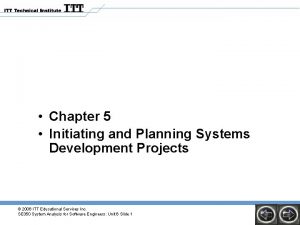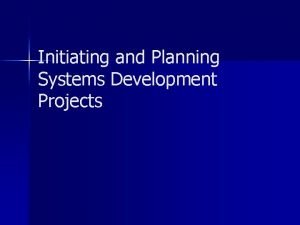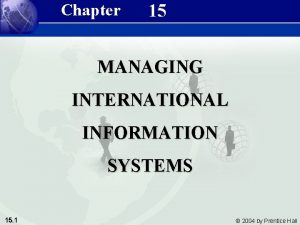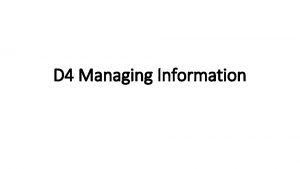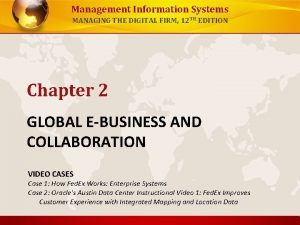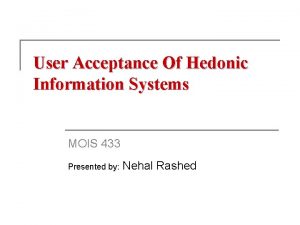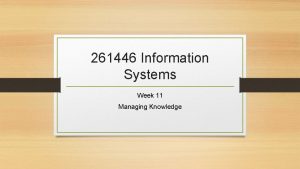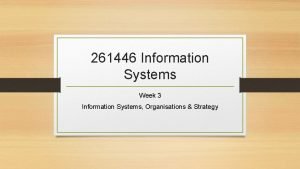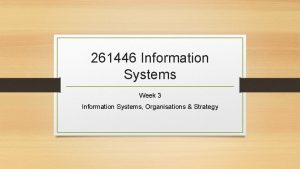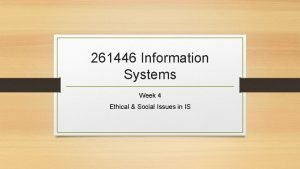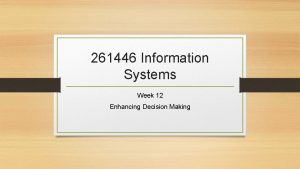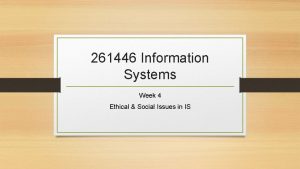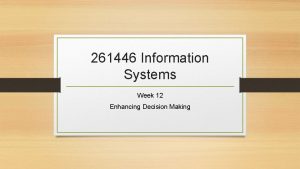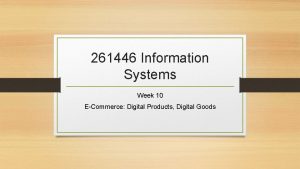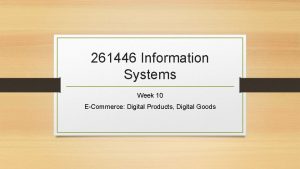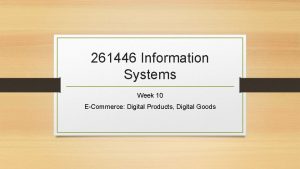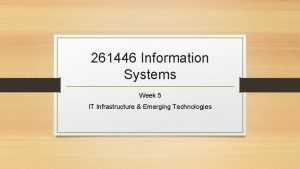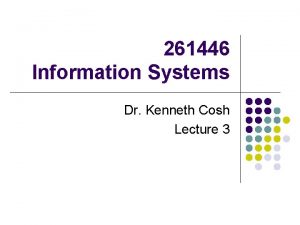261446 Information Systems Week 14 Managing Projects Week






















- Slides: 22

261446 Information Systems Week 14 Managing Projects

Week 14 Topics • Project Management • Selecting Projects • Managing Project Risk

Case Studies • Case Study #1) Stepan Company • Case Study #2) Pennsylvania Unemployment Compensation

Project Management • Many systems fail to deliver the expected results • • Costs vastly exceed budgets Unexpected time slippage Technical performance less than expected Failure to obtain anticipated benefits

Change Management • The introduction of a new information system brings about many organisational changes – these changes need to be managed effectively. • Changes to the way information is defined, accessed and used brings about new distributions of authority and power. • Process change the way groups act and interact. • Internal Changes such as these can breed resistance and opposition if mismanaged. • Many systems have failed due to the organisational change not being properly addressed.

Problems Causing Systems Failure • Design • The systems design may fail to satisfy the business users requirements • Functionally – by failing to be capable of performing a task. • Non-functionally – by not performing well enough, too slow for example. • Poor User Interface • A poor user interface will be rejected by the users.

Problems Causing Systems Failure • Data • Systems fail if the data is inaccurate, inconsistent or inaccessible. • Cost • Systems fail when they run over budget, either through poor budget planning, or through production / implementation costs. • Operations • Systems need to be reliable, secure and usable.

Implementation • Systems Analysts act as Change Agents, managing the changes brought about by a new information system can be essential for the success of a system. • Factors for Implementation Success and Failure; • User Involvement and Influence • Management Support and Commitment • Level of Complexity / Risk • Implementation Process Management

User Involvement • Users involvement in the design and operation of a system can have positive results • They can mold the system according to their priorities and business requirements. • They can control the outcome. • They will react more positively to the completed system (defensively even).

User Involvement • 1) With the widespread use of the internet and 4 th generation tools, users can take more of a leadership role in systems development / implementation. (Kettinger / Lee) • 2) Users may take a narrow / limited view of their problems, overlooking some important technological aspects – would you build a new house without an architect? (Markus / Keil)

User-Designer communications gap • User’s and IS specialists have a different understanding / approach / vocabulary. • IS Specialists often look for highly technical solutions, with elegant and sophisticated use of software and hardware with operational efficiency optimised at the expense of organisational effectiveness. • Users focus on solving today’s business tasks with little regard for efficiency. • If the User-Designer communications gap is large, systems development projects carry more risk of failure as different project parts pursue alternative goals.

Management Support and Commitment • If an information system doesn’t have full management support and commitment throughout its lifetime, it is not likely to be perceived positively by users or specialists – as with any management initiative.

Level of Complexity and Risk • Different types of Systems projects naturally carry different levels of risk and complexity.

Varying Degrees of Risk • Project Size • A larger project has inherently greater risk. • If a comparatively large project goes wrong the damage is greater than if a comparatively small project goes wrong. • Technological Experience • New Technology carries greater risk • Inexperienced, less technically advanced, users carry greater risk • Project Structure • Projects requiring organisational change carry greater risk • Projects with clearly defined objectives and outputs carry less risk.

Low Risk • Introducing a spreadsheet to aid the accounts department with their budgeting • Comparatively Small Project • No new technology for experienced users • Little organisational change • Clearly defined objectives

High Risk • Artificially Intelligent Bond Trading System • • • Large Project New Technology Users inexperienced with A. I. systems Changes in the organisational process as A. I. system takes over human role. Objectives clearly defined?

N. B. Portfolio risk • It is common for there to be many systems being introduced simultaneously. Whilst each individually may carry little inherent risk, they may have combined impact. • Stability of IT development group • Quality of IT development group • Corporate perception of IT • Recent Successes / Failures of IT

Risk / Reward

Management of the Implementation Process • 80% of all software projects exceed their budgets, running on average 50% over budget. • Why? • Ignorance and Optimism • Estimation techniques are poorly developed, especially as most applications are ‘first timers’ with little experience. • Mythical Man Months • Systems development projects are often sequential, rather than parallel – i. e. adding more manpower won’t necessarily speed the process up. • Bad news travels slowly upwards • Managers aren’t informed about any delays, problems etc. in a project.

Managing Implementation • Controlling Risk Factors • Managing Technical Complexity • Formal Planning and Control Tools • Increasing User Involvement & Overcoming User Resistance • Designing For the Organisation • Human Factors • Sociotechnical Design

Controlling Risk Factors • Managing Technical Complexity • Project leaders should have good technical experience. • Frequent Team meetings. • All essential technical skills should be assured, internally or externally. • Formal Planning and Control Tools • PERT Diagrams, Gantt Charts to help manage through a project • Increasing User Involvement • External Integration • Integrating users within the project team • Internal Integration • Developing project TEAM

Designing for the organisation • Measure the success of a project in human terms as well as memory size and calculation times. • Experiment with social solutions as well as purely technical solutions – result in a sociotechnical solution.
 Managing and using information systems
Managing and using information systems Management information systems managing the digital firm
Management information systems managing the digital firm Managing multiple projects objectives and deadlines
Managing multiple projects objectives and deadlines Managing and leading software projects
Managing and leading software projects Initiating and planning systems development projects
Initiating and planning systems development projects Identifying and selecting systems development projects
Identifying and selecting systems development projects Initiating and planning systems development projects
Initiating and planning systems development projects Week by week plans for documenting children's development
Week by week plans for documenting children's development Managing global systems chapter 15
Managing global systems chapter 15 Global systems 1 management
Global systems 1 management Managing global systems
Managing global systems Analyzing and using marketing information
Analyzing and using marketing information Procedures relating to the management of information
Procedures relating to the management of information Information technology resource management
Information technology resource management Management information system managing the digital firm
Management information system managing the digital firm Importance of rest
Importance of rest Managing marketing information
Managing marketing information Embedded systems week
Embedded systems week Decision support systems and intelligent systems
Decision support systems and intelligent systems Dicapine
Dicapine Embedded systems vs cyber physical systems
Embedded systems vs cyber physical systems Elegant systems
Elegant systems User acceptance of hedonic information systems
User acceptance of hedonic information systems




